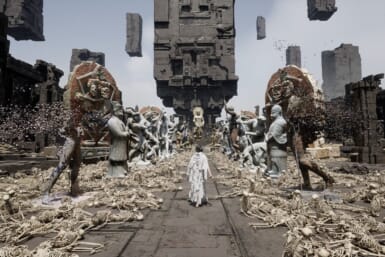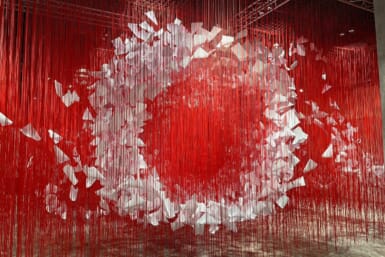When Guardian writer Jonathan Jones decided to “confess” to his critical dislike of Anish Kapoor something didn’t sit right with me. I don’t dislike Jones. If I did, I wouldn’t bother to read his column, although I do frequently disagree with it. And he does occasionally write a show-stopper such as, “Anish Kapoor’s colonisation of British public space continues.” (I mean, you’re kidding right? An artist born in India, and you’re actually going to characterize him as “colonising” British public space? Was that supposed to be irony?)
But regarding Kapoor’s recent sculpture Temenos, and his work in general, Jones writes:
“His sculptures do not frighten the horses. They are essentially decorative, often gorgeously so, but they lack all profundity. Compare his use of colour with Mark Rothko’s purple murals in the Tate Modern and you will see the difference between Kapoor and a great artist.”
I’ve stated my reasons in the past as to why I believe Kapoor’s sculptures are as deeply appreciated as they are. It is not because they are pretty. It is because they play with form and colour, and at times sound, in ways that involve the viewer intimately. They are beautifully wrought, as Jones at least admits, but I would hardly call them decorative.
Kapoor’s work is not easy. It is not witty or satiric. It does not frighten the horses precisely because the horses, unlike their human riders, don’t have the capacity to think about form, shape, light, reflection and colour. Kapoor does not make shocking art, no. Is that what it now takes to be “good”? To be “cool”? Perhaps making considered and intelligent work is now considered too staid.
Jones’s so-called confession implies that he is somehow speaking out against this army of eager (though clearly boring) Kapoor fans who have art critics cowering in their boots, “scared to say anything bad.” Obviously he hasn’t been reading the reactions to the proposed Olympic Park tower. It seems to me that there is more than enough Kapoor criticism floating around to make for a balanced debate. And let’s face it, the tower is showy, but pretty darn ugly.
But all of this aside, after some reflection I realized there was more to this issue than just the matter of taste thrown around with a bit of hyperbole. There is also a kind of false binary being set up between Kapoor and Damien Hirst, and you are expected to pick a side, as if the two of them represented political parties.
Now, Jones has picked his side. Mostly. He writes one article on why he loves Hirst’s work, then slams him later, then writes more praise, then says he will never write about Hirst again… and then writes about Hirst again to explain how he doesn’t know what to feel about him. It’s like a teen romance, but at least it’s frank. Being disappointed by an artist does feel a bit like being jilted: he’s just not the artist you thought he was.
But what I am left baffled by is why people — critics, journalists and audiences alike — are so unable to accept that an artist can produce both good and bad work? When people like a work, the artist is a genius. When the same artist produces another work they fall all over themselves to praise it, because we have already established that he or she is a genius. But those who recognize that the work is weak will immediately declare the artist a hack, a charlatan, not even worthy of being called an artist at all. The decision is also retroactive. All previous work shall henceforth be regarded as rubbish and lies.
Kapoor has moments of genius and moments of dullness. Not every work strikes the mark, and that’s fine. Personally, I think he is at least more consistent in his aims than Hirst. At times it seems that Hirst’s ideas are those that struck a chord almost despite themselves. I sometimes think that Jim Lambie and Damien Hirst both fall into this category: conceptual artists whose concepts aren’t half as clever as the potential contained in the final product (although at least in Lambie’s case, he seldom makes claims to big concepts and often admits to going by feel.) In these cases, it is the critic taking the work out of the artists’ hands and assigning it a perfectly relevant meaning and context beyond what the artist ever intended. These works aren’t failures. They’re successes.
So, go on. It’s okay. You can like Hirst and Kapoor, and I won’t even care. Or better still, pick the works that you like and slam the works that you dislike. It seems to me that deciding who the “great” artists are is as much a fool’s errand as attempting to see the future.









